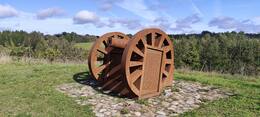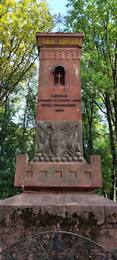Battle of Širvintos Giedraičiai
I Wars of Independence
The Battle of Širvintos Giedraičiai was the last battle of the Lithuanian army against the Central Lithuanian military forces, after which an armistice agreement was signed between Lithuania and Poland. It was also the most memorable battle of the Lithuanian army against the Polish army in the interwar period. On November 17, 1920, large forces of the Central Lithuanian army attacked units of the 1st Infantry Division of the Lithuanian army throughout the division's defense sector, which covered about 30 km. in width, broke through the front and occupied the towns of Širvintos and Giedraičiai. The attack of the Polish army in the 1st Infantry Division was stopped only by the 4th Infantry Division near Musnininkai, and the 2nd Infantry Division and 7th Infantry Division operating in the same defense sector were forced to retreat. At the same time, a very great threat to the Lithuanian army units standing at the front was posed by Col. The cavalry brigade of the Central Lithuanian Army led by Mistislav Butkevičius breaks into the depths of Lithuania through Želva, Kurkliai, Kavarskas and Šėta. On November 21, this brigade reached Kėdainiai and forced the Lithuanian army to prepare for the defense of the city.
The most difficult situation developed on the front section of the 1st Infantry Division, as the Lithuanian army units had to leave the defense line and retreat. The situation in this section was saved and the attack of the units of Gen. L. Želigovskis was stopped by the march of the commander of the 7th Infantry Division, Senior Lieutenant Teodoras Balnas, on the night of November 19. The commander of the 7th Infantry Division bypassed the Polish positions from the left flank, attacked Širvintas and forced the units of the Central Lithuanian Army to briefly withdraw from Širvintas. However, the 2nd Battalion of the 7th Infantry Division, marching along the Ukmergė–Širvintas road, was late in attacking and did not come to the aid of the 3rd Battalion of the 7th Infantry Division, which had already occupied the town. Without receiving help, Senior Lieutenant T. Balnas had to abandon Širvintas, and on November 20, they were again occupied by the units of L. Želigovskis. Thus, the result of the two-day battle was that the Lithuanian army was forced to retreat from its former defense line, and Giedraičiai and Širvintos, despite efforts to retake them, remained in the hands of L. Želigovskis' units.
The battles between the Lithuanian and Polish armies that took place on November 17–19 led to the intervention of the League of Nations Control Commission, which informed the Lithuanian government and the headquarters of the First Polish Army at 2 a.m. on November 21. L. Želigovskis agreed to suspend active hostilities at 6 p.m. on November 20 and went on the defensive. The League of Nations Control Commission demanded that the Lithuanian authorities suspend offensive operations by 9 a.m. on November 21. Despite this, the Lithuanian military command continued to prepare for the offensive – it ordered an attack and to retake the lost positions by 9 a.m. on November 21.
The Lithuanian army's offensive began on the night of November 21, when the commander of the 7th Infantry Regiment, Senior Lieutenant T. Balnas, repeated the march that had taken place a couple of days earlier and captured Širvintas, the 2nd Infantry Regiment - Giedraičiai, and the 8th Infantry Regiment cut off the Polish communication between Giedraičiai and Širvintas. The actions of the 2nd Infantry Regiment were stopped on November 21 at 5 p.m. After this attack, the Lithuanian army regained the positions lost during the attack of the units of Gen. L. Želigovskis on November 17. The Širvintas-Giedraičiai battle was the last clash of the Lithuanian and Central Lithuanian armies on the battlefield.
More information sources
- Vytautas Lesčius, The Lithuanian Army in the Struggle for Independence 1918–1920, Vilnius, 2004.
Related timeline
Related objects
A stylised cannon commemorating the 100th anniversary of the Battle of Giedraičiai
A stylised cannon commemorating the 100th anniversary of the Battle of Giedraičiai is located behind the town of Giedraičiai, 200 m after turning off on road No. 172.
On 21 November 2020, a monument by sculptor Džiugas Jurkūnas was unveiled on a hill at the site of the Battle of Giedraičiai, commemorating the victory. The monument is a stylised interpretation of the battles of the Lithuanian Army against the Polish Army during the inter-war period. In an attempt to move away from the description of the conflict, the monument highlights the importance of the union of the two countries in the context of contemporary events. The rust-covered cannon symbolises the strong union of the re publics of Lithuania and Poland – two countries that fought each other a century before. The situation of the time is described on the sides of the monument; the Lithuanian and Polish Army units involved are mentioned and a brief description of the battle is provided. The Lithuanian Armed Forces are the initiator and the funder of the erection of the monument
Monument to the Soldiers Killed for Lithuania‘s Freedom in 1920
The monument is located in Giedraičiai.
On 19 June 1932, a monument dedicated to the fallen Lithuanian freedom fighters was unveiled in Giedraičiai. The construction of the monument was initiated by the inhabitants of Giedraičiai – the painter and author of the monument Antanas Jaroševičius, Pastor Meigis, Malvina Valeikienė and Matas Valeika, who sup ported the Lithuanian soldiers in battle, the community of Širvintos and the Lithuanian Army; the amount of 11,000 litas was raised for the construction of the monument. The appeal for donations for the monument states that it is being built “to honour victory and our eternal joy, which will remind us of the historical significance of the site and pay tribute to the soldiers buried in Giedraičiai”. The opening ceremony was sumptuous. It was attended by the President of the Republic of Lithuania, A. Smetona – Command er-in-Chief of the Lithuanian Armed Forces, representatives of the 2nd, 4th, 7th, and 9th Regiments and officers, who took part in the Battles of Giedraičiai. Flowers were dropped at the monument from military planes, and Malvina Valeikienė, a prominent Lithu anian personality and one of the organisers of the construction works of the monument, read out the names of the Lithuanian soldiers who died in Giedraičiai, and she was awarded the Order of the Cross of the Knight, 3rd Class. The flag of the local rifle men unit was consecrated at the monument. From 1962–1964, pursuant to the instructions of the Soviet administration, an un successful attempt was made to demolish the monument, but it was later declared a historical monument.






